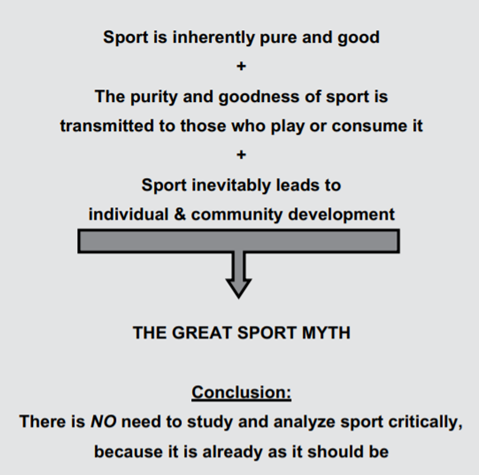The purpose of this article is to briefly introduce the Critical Positive Youth Development (CPYD) framework. Coaches and athletes are encouraged to read further about the framework, and can access the full paper here.
The Great Sports Myth
Many believe that sport is inherently good, and that positive experiences through sport are an inevitable by-product of participation. This in turn has led many to believe that sport, particularly youth and adolescent sport, need not be critically analyzed – especially from a sociological perspective. This is what Coakley (2015) refers to as the Great Sports Myth.

Indeed, youth and adolescent sport participation have been linked to both positive and negative developmental outcomes (e.g., Camiré & Trudel, 2010). That said, coaches are particularly valuable in youth and adolescent sport contexts because they are responsible for creating the environments in which young athletes learn and develop (Gould & Carson, 2008).
In other words, the positives of youth and adolescent sport participation may outweigh the negatives when coaches are competent and caring, and when learning environments are appropriately structured to foster specific developmental outcomes (Holt et al., 2017).
Furthermore, the roles of coaches, and the learning environments they create, are so important because coaches have been shown to exert significant influence over youth athletes within the context of sport, but also beyond sport, in different areas of youth and adolescents’ lives (Carson Sackett & Gano-Overway, 2017).
Considering the push back from critical scholars against the Great Sports Myth, the influential roles of coaches, and the increasing awareness of social justice issues in sport, it is important to ask: what type of influence do youth and adolescent sport coaches have over their athletes’ social activism?
Sport as a Vehicle for Change… But Where is it Going?
Recognizing the recent social justice movements that have begun to spur collective positive social change, such as Black Lives Matter and #MeToo, it has become increasingly important to question the role and capacity of sport to contribute to this positive social change.
While coaches have traditionally been focused on facilitating performance outcomes in their young athletes, scholars have pointed out that it would be a missed opportunity to ignore the wide range of psychosocial outcomes that coaches can influence (Mallett & Rynne, 2010) – and that includes advocacy for social justice issues.
What I think is most important to consider at this point is the metaphor that sport is merely a vehicle, which may be used for positive social change when the right individuals are driving in a desirable direction. What’s more, this doesn’t happen automatically: the vehicle can sit idle, with nobody driving it, or it can be driven (by a coach) in a direction that is not ideal for its passengers (i.e., youth athletes). Being critical about the vehicle, and the directions in which this vehicle is headed, is key if we are to make sport an optimal site for both the development of young athletes and for positive, progressive social change.
This is where the Critical Positive Youth Development (CPYD) Framework from Gonzalez and colleagues (2020) comes into play.
The Critical Positive Youth Development (CPYD) Framework
The CPYD framework is an updated critical conception of the Positive Youth Development (PYD). Crucially, the CPYD framework moves past the PYD framework by acknowledging the ways in which systemic inequity affects the lives of youth and adolescents – something the PYD fails to accomplish.
The Five Cs model of PYD outlines five psychological, behavioural, and social characteristics that indicate when youth and adolescents are thriving (Lerner et al., 2005). These five Cs are:
- Competence
- Confidence
- Connection
- Caring
- Character
When the five Cs are present, a sixth C emerges:
- Contribution
Critical Consciousness
The Five Cs model is focused on the positive ways in which youth and adolescents move towards leading productive and healthy lives. The CPYD builds on the Five Cs model by suggesting a seventh C:
Critical consciousness was initially coined and developed by Brazilian educator and activist Paulo Freire in his books Pedagogy of the Oppressed (1970) and Education for Critical Consciousness (1973).
A cyclical process, critical consciousness consists of reflection and action, which work together to influence each other in an iterative manner. Reflection influences action, which then influences reflection – and the cycle continues.
Critical consciousness is made up of three interconnected components:
- Critical Reflection: acknowledging and understanding oppression and marginalization of certain groups and individuals.
- Political Efficacy: a person’s belief in their ability to act against oppression and marginalization.
- Critical Action: efforts of positive social activism or advocacy in response to oppression and marginalization of certain groups and individuals.
Five Essential Propositions for CPYD
Gonzalez and colleagues (2020) outlined five essential propositions for the CPYD framework.
- Understanding the impact of power, privilege, and oppression requires a critical lens.
- The Five Cs of PYD must be developed before critical consciousness can be developed.
- Critical reflection and political efficacy strengthen the Five Cs of PYD.
- Critical consciousness underpins the CPYD framework, thus changing how youth engage in contribution.
- When youth contribute through critical action, they reinforce the Five Cs, critical reflection, and political efficacy.
All youth and adolescents can benefit from the development of critical consciousness. Moreover, all athletes stand to benefit when coaches assume the challenge of coaching differently (Denison, 2017), which includes making active efforts to promote, address, and support social justice advocacy and activism.
From a CPYD perspective, coaching differently means putting more of an emphasis on the development of critical consciousness in both coaches and athletes.
Why the CPYD is Important for Coaches
The CPYD is so very valuable for coaches, as well as for athletes, because the development of critical consciousness has been shown to be not only important for individuals who experience marginalization and oppression themselves, but is also vital for those with privileged social identities who are actively seeking to be allies (Love, 2000).
Further, the normative, functionalist perspectives in sport, which are maintained by dominant perspectives (e.g., White, able-bodied, cis-gendered, heterosexual, male), have been shown to marginalize certain groups of youth and adolescents. This, in turn, can make some youth and adolescents feel unsafe during sport participation, or, in some cases, even less likely to participate in general (Kulick et al., 2019).
If sport is a place where inclusivity is truly of high importance, as it is often said to be, then everyone involved in youth and adolescent sport must be more critical about the ways in which coaches create learning environments for their athletes.
The CPYD framework suggests critical consciousness as a starting point for this critical examination of coaching in youth and adolescent sport in regards to social justice. For more information about the framework and how one might implement it into coaching practices, I strongly encourage reading the full paper from Gonzalez and colleagues.
* * *
About The Author
Evan Bishop is an educator and a Brazilian Jiu-Jitsu Brown Belt, who writes articles about exercise and sports psychology, pedagogy (the art of teaching) and learning. He graduated with a B.Ed. in Physical and Health Education, and is currently a graduate student in the field of sport psychology. If you’re intrigued by what you’ve read here, you can check out a similar article from my personal blog about my thoughts on the importance of critical race theory in sport.
References
- Camiré, M., & Trudel, P. (2010). High school athletes’ perspectives on character development through sport participation. Physical Education & Sport Pedagogy, 15(2), 193–207. https://doi.org/10.1080/17408980902877617
- Carson Sackett, S., & Gano-Overway, L. A. (2017). Coaching life skills development: Best practices and high school tennis coach exemplar. International Sport Coaching Journal, 4(2), 206–219. https://doi.org/10.1123/iscj.2016-0080
- Coakley, J. (2015). Assessing the sociology of sport: On cultural sensibilities and the great sport myth. International Review for the Sociology of Sport, 50(4–5), 402–406. https://doi.org/10.1177/1012690214538864
- Denison, J., Mills, J. P., & Konoval, T. (2017). Sports’ disciplinary legacy and the challenge of ‘coaching differently’. Sport, Education and Society, 22(6), 772-783. http://dx.doi.org/10.1080/13573322.2015.1061986
- Freire, P. (1973). Education for critical consciousness. Continuum International Publishing Group.
- Freire, P. (2000). Pedagogy of the oppressed (30th Anniversary Edition). Continuum
- International Publishing Group. (Original work published 1970.) Fuller, R., & Agyemang, K. J. A. (2018). An examination of activism and NCAA Division III Black male athletes. International Journal of Sport Management, 19(2), 186–206.
- Gonzalez, M., Kokozos, M., Byrd, C., & McKee, K. (2020). Critical positive youth development: A framework for centering critical consciousness. Journal of Youth Development, 15(6), 24-43. https://doi.org/10.5195/jyd.2020.859
- Gould, D., & Carson, S. (2008). Life skills development through sport: Current status and future directions. International Review of Sport and Exercise Psychology, 1(1), 58–78. https://doi.org/10.1080/17509840701834573
- Holt, N. L., Neely, K. C., Slater, L., Camiré, M., Côté, J., Fraser-Thomas, J., MacDonald,
- D., Strachan, L., & Tamminen, K. (2017). A grounded theory of positive youth development through sport based on results from a qualitative meta-study. International Review of Sport and Exercise Psychology, 10(1), 1-49. https://doi.org/10.1080/1750984X.2016.1180704
- Kulick, A., Wernick, L., Espinoza, M., Newman, T., & Dessel, A. (2019). Three strikes and you’re out: Culture, facilities, and participation among LGBTQ youth in sports. Sport, Education and Society, 24(9), 939-953. https://doi.org/10.1080/13573322.2018.1532406
- Love, B. J. (2000). Developing a liberatory consciousness. In M. Adams, W. J. Blumenfeld, C.
- R., Casteneda, H. W. Hackman, M. L. Peters, & X. Zúñiga (Eds.), Readings for diversity and social justice (pp. 599-604). Routledge.
- Mallett, C. J., & Rynne, S. B. (2010). Holism in sports coaching: Beyond humanistic psychology: A commentary. International Journal of Sports Science and Coaching, 5(4), 453–457.





